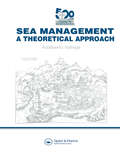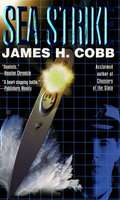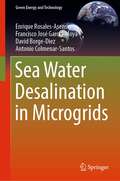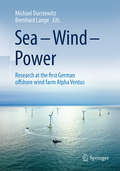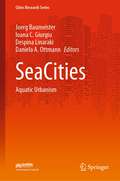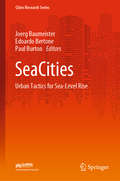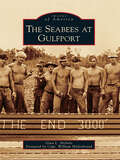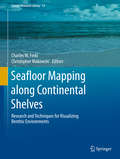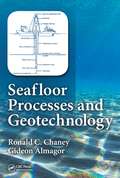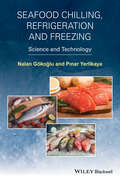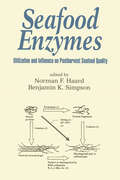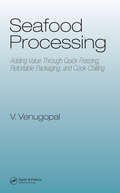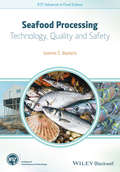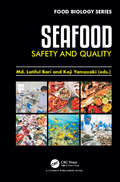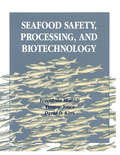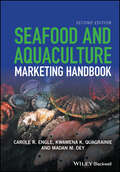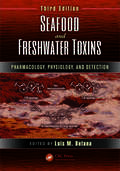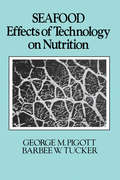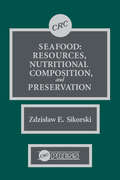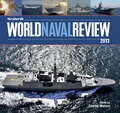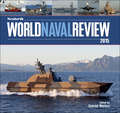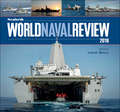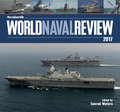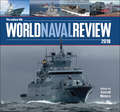- Table View
- List View
Sea Management: A theoretical approach
by Adalberto VallegaThis book has been conceived with the aim of contributing to the International Conference on Ocean Management in Global Change [Genoa, June 22-26, 1992] and to the ocean sciences' debate on the conceptual framework and targets of sea management.
Sea Strike
by James H. CobbPacked with electrifying action and cutting-edge technology, Sea Fighter takes Commander Amanda Lee Garret on her most explosive mission yet: to stop a renegade Nigerian general before his bloody quest for power reaches catastrophic proportions...
Sea Water Desalination in Microgrids (Green Energy and Technology)
by Antonio Colmenar-Santos Enrique Rosales-Asensio David Borge-Diez Francisco José García-MoyaThis book investigates the sustainability performance of system that use microgrids in desalination processes. Climate change may be especially dramatic in its effects on island environments. In these environments, aquifers and wells could become over exploited resulting the use of desalination plans. The synergies between water, energy, and food sectors have been identified as vital in achieving the United Nation’s Sustainable Development Goals.The book explores desalination and microgrids technically as well the economic and legal aspects that must be considered in order explore their techno-economic feasibility - analyzing how to improve the desalination process, proposing a method to locate and size a microgrid. Other synergies between the water, energy, and food system are discussed and the benefits to society that might result in these systems. Also, the lessons learned are highlighted in the context of how they may apply to other sustainable enterprises.
Sea – Wind – Power
by Michael Durstewitz Bernhard LangeThis book reports on the objectives, methods used and difficulties faced by the RAVE research projects, and presents the results and their significance for the future use of offshore wind energy in a style that is understandable for everyone. Readers are given a comprehensive overview of the current status of offshore wind energy research and the results of the research activities. Offshore wind energy will play a significant role in our future energy supply, yet this development has really only just begun. A large team of experts from the fields of research, industry, public administration and government therefore set themselves the goal of investigating the current and fundamental issues relating to the use of offshore wind energy. They worked on interdisciplinary research projects with the aim of expanding our knowledge and finding application-oriented solutions. Their work has contributed to establishing offshore wind energy as a reliable, sustainable and economical long term source of energy.
SeaCities: Aquatic Urbanism (Cities Research Series)
by Joerg Baumeister Daniela A. Ottmann Ioana C. Giurgiu Despina LinarakiThis book highlights the research outcome of Cities Research Institute's SeaCities group at Griffith University and a panel with the same title which took place at the World Expo in Dubai 2021/22 supported by the UN. It reflects on topics which are relevant for a future aquatic urbanism like the evolution of a taxonomy for aquatic urbanism, island and ecological wetland development, the planning aspects of seascapes, as well as drivers for floating communities and aquacultural urbanism. The book broadens the perspective of the previous book "SeaCities: Urban Tactics for Sea-Level Rise" published in 2021 from a terrestrial towards an amphibious and aquatic understanding of future city development.
SeaCities: Urban Tactics for Sea-Level Rise (Cities Research Series)
by Joerg Baumeister Edoardo Bertone Paul BurtonThis book presents and discusses a strategy which includes four approaches to dealing with the risk of sea-level rise and other water hazards. It also offers opportunities for cities to explore urban extensions such as marine estates, aquatic food production systems, new sea related industries, maritime transport developments, new oceanic tourist attractions, and the designation of additional coastal ecological zones. The urban interface between Sea and Cities generates, therefore, both burning issues and valuable opportunities and raises the question of whether it is possible to solve the former by exploiting the latter?
Seabees at Gulfport, The (Images of America)
by Capt. William Hilderbrand Gina L. NicholsIn June 1942, the U.S. Navy established an advance base depot in Gulfport because of its uncrowded deepwater port, rail access, open land, and a tepid climate that permitted training and open port facilities year-round. The base became the southern home for the Seabees and was ideal for shipping construction materiel and men to the Caribbean or the Pacific via the Panama Canal. Since the base reopened in March 1966, Seabees have deployed from Gulfport to serve during major conflicts as well as in peacetime. Seabees from Gulfport played an integral part in Operation Desert Shield/Desert Storm and more recently deployed to Afghanistan and Iraq to assist in local construction efforts to rebuild both countries. Seabees assist thousands each year in international humanitarian projects while still calling Gulfport home.
Seabees at Port Hueneme, The (Images of America)
by Gina NicholsIn 1942, the navy sought a location for an advance base on the West Coast to ship construction materiel, equipment, and men into World War II's Pacific theater. Port Hueneme's deepwater harbor, rail system, and rural setting made it the ideal site from which to send 20 million measurement tons of war materiel and a quarter of a million men onto island specks that later became headlines: Guadalcanal, Tarawa, Iwo Jima, Okinawa, and the Philippines. Seabees later deployed from Port Hueneme to serve in the Korean, Vietnam, Desert Shield/Desert Storm, and Iraqi conflicts, as well as in peacetime, for more than 60 years. Charged with building air bases, ports, combat camps, hospitals, and other support facilities as part of military and humanitarianefforts around the world, the Seabees remain at home in Port Hueneme.
Seafloor Mapping along Continental Shelves
by Charles W. Finkl Christopher MakowskiThis university-level reference work covers a range of remote sensing techniques that are useful for mapping and visualizing benthic environments on continental shelves. Chapters focus on overviews of the history and future of seafloor mapping techniques, cartographical visualisation and communication of seafloor mapping, and practical applications of new technologies. Seabed mapping is referenced by high-resolution seismic methods, sidescan sonar, multibeam bathymetry, satellite imagery, LiDAR, acoustic backscatter techniques, and soundscape ecology monitoring, use of autonomous underwater vehicles, among other methods. The wide breadth of subjects in this volume provides diversified coverage of seafloor imaging. This collection of modern seafloor mapping techniques summarizes the state of the art methods for mapping continental shelves.
Seafloor Processes and Geotechnology
by Ronald Chaney Gideon AlmagorAn ideal resource for civil engineers working with offshore structures, pipelines, dredging, and coastal erosion, Seafloor Processes and Geotechnology bridges the gap between the standard soil mechanics curriculum of civil engineering and published material on marine geotechnology. Utilizing organized information on sediments and foundations for ma
Seafood Chilling, Refrigeration and Freezing: Science and Technology
by Nalan Gokoglu Pinar YerlikayaFish and seafood are highly perishable, and must be preserved immediately after being caught or harvested. It is very important both to preserving its quality and to ensure that it does not pose any risks to human health upon consumption. Chilling, refrigeration and freezing are the major preservation methods used with seafood and fish products, all three processes aiming to preserve the freshness and flavour of the fish. Consumer demand for fish remains high despite escalating prices in the last ten years which have seen the retail cost of the most popular breeds (cod, haddock, salmon) more than double for unfrozen fish. Many consumers appear to be willing to pay a premium for freshness and quality, both of which are closely linked in shoppers’ minds with the efficient chilling and refrigeration of the fish along the supply chain. At the same time, frozen fish and seafood has also grown more popular with shoppers, as a cheaper, more convenient alternative to refrigerated fresh fish and seafood. Seafood Chilling, Refrigeration and Freezing presents the science behind the chilling, refrigerating and freezing of fish and seafood, describing the chemical, microbiological and physical changes which take place during preservation, and considering the new technologies which can be used, highlighting their benefits and their economic implications. The book takes account of the different requirements for different breeds of fish and seafood, and includes both traditional and novel technologies, providing both current and future perspectives. It will be required reading for food scientists, fish processors and retailers as well as fish specialists, researchers and process designers.
Seafood Enzymes: Utilization and Influence on Postharvest Seafood Quality (Food Science and Technology)
by Norman F. Haard Benjamin K. Simpson"Reviews specific enzymes and enzyme groups studied in recent years, delves into the relationship between enzymes and seafood quality, covers the application of enzymes as seafood processing aids, and focuses on the recovery of useful enzymes as by-products from seafood waste. Details the control of enzyme activity in seafood products."
Seafood Processing: Adding Value Through Quick Freezing, Retortable Packaging and Cook-Chilling (Food Science and Technology)
by V. VenugopalWith global fish production falling behind demand, the aquaculture of selected species has become an effective method to augment fish availability. Unlike natural species, however, cultured fish have limited consumer appeal. Value addition techniques can not only help satisfy the rising consumer demand for processed fishery products but also enhanc
Seafood Processing: Technology, Quality and Safety (IFST Advances in Food Science)
by Ioannis S. BoziarisPart of the new IFST Advances in Food Science Series, Seafood Processing: Technology, Quality and Safety covers the whole range of current processes which are applied to seafood, as well as quality and safety aspects. The first part of the book (‘Processing Technologies’) covers primary processing, heating, chilling, freezing, irradiation, traditional preservation methods (salting, drying, smoking, fermentation, etc), frozen surimi and packaging. The subjects of waste management and sustainability issues of fish processing are also covered. In the second part (‘Quality and Safety Issues’), quality and safety analysis, fish and seafood authenticity and risk assessment are included.
Seafood Safety and Quality (Food Biology Series)
by Md. Latiful Bari Koji YamazakiSeafood Safety and Quality continues to be a major public health issue and its importance has escalated to unprecedented levels in recent years. In this book, major seafood borne diseases and key safety issues are reviewed. In addition, emerging microbial agents, fish toxins and other contaminants including heavy metal; allergy, water safety and related topics are discussed. It also addresses the challenges faced by both developed and developing countries to ensure seafood safety in new seafood products and processing technologies, seafood trade, safety of foods derived from biotechnology, microbiological risks, emergence of new and antibioticresistant pathogens, particularly from emerging pathogens, directing research to areas of high-risk, focus intervention and establishment of target risk levels and target diseases or pathogens. The book serves as a comprehensive resource on the seafood borne diseases and a wide variety of responsible etiologic agents, including bacteria, viruses, parasites, seafood toxins, and environmental toxins. It has been written in a simple manner and should promote the efforts of the scientific community to deliver safe seafood for a better health and environment.
Seafood Safety, Processing, and Biotechnology
by Fereidoon Shahidi, Yvonne Jones and David D. KittsResearch and development of seafood continues to be productive in terms of new and improved products for both food and non-food purposes. The use of biotechnology, microbiology, computer modeling and advanced analytical techniques has led to improvements in processing and product safety. This recent book provides extensive new information on these developments. The 25 reports were prepared by food scientists specializing in seafood. The reports are well illustrated with numerous schematics and some micrographs. Extensive reference data is provided in tables and graphs.
Seafood and Aquaculture Marketing Handbook
by Carole R. Engle Kwamena K. Quagrainie Madan M. DeyAquaculture, the farming of aquatic animals and plants, and other seafood businesses continue to grow rapidly around the world. However, many of these businesses fail due to the lack of sufficient attention to marketing. The Seafood and Aquaculture Marketing Handbook provides the reader with a comprehensive, yet user-friendly presentation of key concepts and tools necessary for aquaculture and seafood businesses to evaluate and adapt to changing market conditions.Markets for aquaculture and seafood products are diverse, dynamic, and complex. The Seafood and Aquaculture Marketing Handbook presents fundamental principles of marketing, specific discussion of aquaculture and seafood market channels and supply chains from around the world, and builds towards a step-by-step approach to strategic market planning for successful aquaculture and seafood businesses.This book is an essential reference for all aquaculture and seafood businesses as well as students of aquaculture. The volume contains a series of synopses of specific markets, an extensive annotated bibliography, and webliography for additional sources of information.Written by authors with vast experience in international marketing of aquaculture and seafood products, this volume is a valuable source of guidance for those seeking to identify profitable markets for their aquaculture and seafood products.
Seafood and Freshwater Toxins: Pharmacology, Physiology, and Detection, Third Edition
by Luis M. BotanaThe last few years have brought about many changes in the field of marine and freshwater toxins, with advances in analytical technology and the realization that these toxins are a global issue. Offering a complete reference guide, Seafood and Freshwater Toxins: Pharmacology, Physiology, and Detection, Third Edition addresses all aspects of the soci
Seafood: Effects of Technology on Nutrition (Food Science And Technology Ser. #39)
by George M. Pigott Barbara TuckerAnalyzes how the technology and commercial practices of cultivation affect the nutritive value of certain fish, molluscs, crustacea, and freshwater plants. Organized to reflect the sequence from growth, harvest, and capture, through transportation, storage, and processing, to packaging and distribut
Seafood: Resources, Nutritional Composition, and Preservation
by Zdzislaw E. SikorskiThis must-have resource focuses on marine food composition as it relates to nutrition. Filled with illustrations and graphs, it describes the biological and technical factors which effect the availability and quality of seafood resources and provides information on the biochemical changes, functional properties, contents, and biological value of the main components of the major marine food organisms. It presents the yield of edible parts for the different species and the applied procedures of processing and culinary preparation. This volume is intended for the general reader who is interested in food production, marketing, and nutrition, and is also an ideal text for students of food science as well as professionals in the food trade and fish industry.
Seaforth World Naval Review 2013
by Conrad Waters&“The 2013 edition . . . includes four articles on significant ships, respectively; French Navy, US Coast Guard, German Navy and Indian Navy.&”—Firetrench Reviews Launched in 2009, this annual has rapidly established a reputation as an authoritative but affordable summary of all that has happened in the naval world in the previous twelve months. It combines the standing features of regional surveys with one-off major articles on noteworthy new ships and other important developments. Besides the latest warship projects, it also looks at wider issues of importance to navies, such as aviation and electronics, and calls on expertise from around the globe to give a balanced picture of what is going on and to interpret its significance. Special features for the 2013 edition include in-depth studies of the navies of Italy and Ireland, plus analyses of significant new warship classes: the French Aquitaine class frigates, Indian Shivalik class Project 17 frigates, German Braunschweig class corvettes, and US Bertholf class national security cutters. Intended to make interesting reading as well as providing authoritative reference, there is a strong visual emphasis, including specially commissioned drawings and the most recently released photographs and artists&’ impressions. This annual has become &“a must for those wishing to keep up with world naval affairs&” (Scuttlebutt).
Seaforth World Naval Review 2015: 2015
by Conrad WatersThe &“profusely illustrated&” yearly military reference that features world fleet reviews, significant ship developments, and technological advancements (Ships Monthly). Now in its seventh year, this annual has established an international reputation as an authoritative but affordable summary of all that has happened in the naval world in the previous twelve months. It combines regional surveys with one-off major articles on noteworthy new ships and other important developments. Besides the latest warship projects, it also looks at wider issues of importance to navies, such as aviation and electronics, and calls on expertise from around the globe to give a balanced picture of what is going on and to interpret its significance. The 2015 edition looks in detail at the French Navy and the Bangladesh and Myanmar navies, while significant ships include the Montford Point class mobile landing platforms, the Samuel Beckett offshore patrol vessels, and the Skjold class fast attack craft. There are technological reviews dealing with naval aviation by David Hobbs, and current mine warfare developments by Norman Friedman, while warship recycling is discussed by Ian Buxton. Intended to make interesting reading as well as providing authoritative reference, there is a strong visual emphasis, including specially commissioned drawings and the most up-to-date photographs and artists&’ impressions. For anyone with an interest in contemporary naval affairs, whether an enthusiast or a defense professional, this annual has become required reading.
Seaforth World Naval Review 2016
by Conrad Waters&“The crème de la crème of naval writers . . . an extremely detailed overview of the last year in naval policy, construction and deployment.&”—Warship World This annual has an established reputation as an authoritative but affordable summary of all that has happened in the naval world in the previous twelve months. It combines regional surveys with one-off major articles on noteworthy new ships and other important developments. Besides the latest warship projects, it also looks at wider issues of importance to navies, such as aviation and electronics, and calls on expertise from around the globe to give a balanced picture of what is going on and to interpret its significance. This edition looks in detail at the Royal Navy as it faces the latest defense review, and evaluates the Indonesian Navy, while significant ships will include the USN&’s San Antonio class amphibious transports, the new Dutch OPVs, the Turkish Milgem class corvettes and the Greek Roussen class fast attack craft. There are also technological reviews dealing with naval aviation by David Hobbs, focusing on maritime patrol aircraft, while Norman Friedman surveys recent electronic warfare developments. Intended to make interesting reading as well as providing authoritative reference, there is a strong visual emphasis, including specially commissioned drawings and the most up-to-date photographs and artists&’ impressions. For anyone with an interest in contemporary naval affairs, whether an enthusiast or a defense professional, this annual has become required reading. &“A high-quality, deeply-researched and handsomely-illustrated book.&”—Army Rumour Service
Seaforth World Naval Review 2017
by Conrad Waters&“This fascinating book examines trends in maritime strategy and geopolitics . . . including technological advances and significant new ships.&”—Nautilus Telegraph This annual has an established reputation as an authoritative but affordable summary of all that has happened in the naval world in the previous twelve months. It combines regional surveys with one-off major articles on noteworthy new ships and other important developments. Besides the latest warship projects, it also looks at wider issues of importance to navies, such as aviation and electronics, and calls on expertise from around the globe to give a balanced picture of what is going on and to interpret its significance. Features of this edition include an in-depth analysis of the Royal Netherlands Navy, while Significant Ships will cover the USN&’s radical new Zumwalt class destroyers, the Republic of Korea&’s amphibious assault ship Dokdo, and the JMSDF&’s Akizuki class destroyers, among others. There are also technological reviews dealing with naval aviation by David Hobbs (with a focus on the present state of the RN&’s Fleet Air Arm), while Norman Friedman surveys naval surface-to-surface missiles. The World Naval Review is intended to make interesting reading as well as providing authoritative reference, so there is a strong visual emphasis, including specially commissioned drawings and the most up-to-date photographs and artists&’ impressions. For anyone with an interest in contemporary naval affairs, whether an enthusiast or a defense professional, this annual has become required reading. &“An extraordinarily useful annual from the point of view of a comprehensive update on the world&’s navies . . . a key resource for keeping up, whether in cabin or armchair.&”—Seaweed
Seaforth World Naval Review 2018: 2018
by Conrad WatersThe yearly military reference that&’s &“a well written, easy to read and well illustrated discussion of current naval power world-wide&”—Thomo&’s Hole. Now firmly established as an authoritative but affordable summary of all that has happened in the naval world in the previous twelve months, this annual combines regional surveys with one-off major articles on noteworthy new ships and other important developments. Besides the latest warship projects, it also looks at wider issues of importance to navies, such as aviation and weaponry, and calls on expertise from around the globe to give a balanced picture of what is going on and to interpret its significance. Features of this edition include an analysis of the Republic of Korea Navy and the response to its aggressive northern neighbor. Significant Ships will cover the USN&’s revamped Arleigh Burke class destroyer design, German F125 class frigates, and the RNZN&’s Otago class offshore patrol vessels. There are also technological reviews dealing with naval aviation by David Hobbs, RN missile programs by Richard Scott, while Norman Friedman turns his attention to new generation weapons technology. The World Naval Review is intended to make interesting reading as well as providing authoritative reference, so there is a strong visual emphasis, including specially commissioned drawings and the most up-to-date photographs and artists&’ impressions. For anyone with an interest in contemporary naval affairs, whether an enthusiast or a defense professional, this annual has become required reading.
